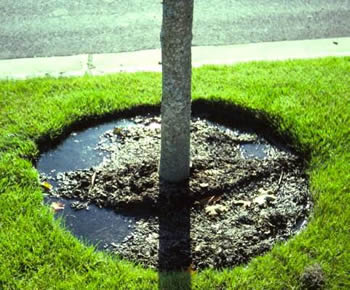The Hidden Costs of Overwatering
Many facilities operate irrigation systems with controllers that are nothing more than glorified timers. In reality, the timers are rarely adjusted, so the typical facility is overwatering its landscape and therefore spending needlessly on water. If it rained recently, or if the weather is warm or cold, the timer applies the same amount of water whether or not the landscape needs it.
Overwatering is even more common than under watering and can lead to serious consequences. Damages from overwatering can include:

- Unhealthy plants or plant loss
- Hardscape damage (brick, hardwood and concrete used in landscaping)
- Slope and foundation damage and increased risk of mold
- Penalties and fines
- Unhealthy fertilizer runoff
- Brand damage (no one views water spilling onto parking lots or sidewalks favorably)
- Increased slips and falls with their inherent liability
Why Focus So Much on Water?
Water rates in major U.S. cities rose 6% from 2014 to 2015, and are up 41% since 2010 (Source: Circle of Blue). Cities are being forced to make difficult decisions due to lack of resources, and costs to repair or retrofit aging water infrastructure are increasing. The natural result is that water prices will continue to rise. As water ordinances increase, so will water-related non-compliance fines. Finally, as homeowners are asked to make water use sacrifices, unintentional water waste by companies can cause significant brand damage among customers.
Leveraging Technology to Save Water and Money
The advent of the Internet of Things (IoT) and big data are powerful tools that are now resulting in extraordinary water and monetary savings through smart water management. IoT provides the ability to cost-effectively establish real-time wireless communication, control and sensing in the field while leveraging the cloud and big data to provide an unprecedented amount of information at an equally unprecedented low cost.
The problem for water management before IoT, big data and cloud solutions were available was the inability to realize cost-effective continuous visibility into a facility’s water use and waste. With affordable real-time flow sensors and wireless technology, facility managers and landscape contractors can be instantly alerted to any leak issue, whether it happens indoors or outdoors, and before they become huge expenses.
Smart water management platforms today are saving leading companies billions of gallons of water, millions of dollars and thousands of staff hours annually. They accomplish this by leveraging field-proven water sensors and water control systems with affordable wireless communications (IoT) that connect these systems to the Internet where huge amounts of data can be affordably stored (cloud) and analyzed (big data) to deliver business intelligence.
By creating building water use footprints across their portfolios, companies can identify use anomalies and potential liabilities. Similarly, by understanding site water demands and weather normalization, facility managers can manage water use through real-time dashboards that allow proactive budget monitoring.
How to Select a Smart Water Management Solution?
Consider three critical issues:
System track record: If the water management solution is smart irrigation, ensure it is certified (such as by WaterSense, a partnership program by the U.S. Environmental Protection Agency) and check recent references of customer sites similar to yours. Additionally, have any independent studies been performed on the technology? If so, how many and by whom?
Total cost of ownership: Don’t be lured into systems that tout low costs only to realize later that these “low-cost” solutions fail to deliver more than average savings and that the technology requires frequent recalibration or replacement to remain accurate. Instead, look at the total cost of ownership and compare on that basis. Look at the technology choices offered by large retailers, as they are always looking at the long view when selecting technology and are extremely cost conscious.
Extensibility of solution: Is the solution based on an entire platform that allows you to efficiently and economically add additional solutions and address new pain points as they arise? Can it, for instance, interact with smart building systems? Is there an integration application program interface available?
The Bottom Line is Actionable Knowledge
IoT and big data have certainly been dragged into the world of major buzzwords, which should always trigger caution. The key is to make sure your first foray into the world of IoT and big data makes economic and operational sense — do not fall victim to data for data’s sake. Make sure your system delivers what really matters — actionable knowledge that saves your team time, money and, ideally, one of the planet’s most precious resources.

